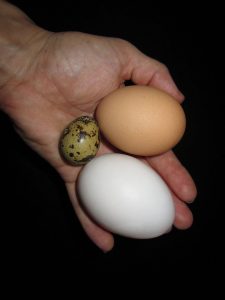 How Many Eggs from Quail
How Many Eggs from Quail
On average Japanese quail will lay 300 eggs per year, and you will often find they lay twice a day in summer months. To achieve this and keep the birds laying year round you will need to maintain light levels for 16 hours a day, although this will lead to egg laying dropping off sooner in their adult life as all laying birds only have limited egg laying potential.
Extending Egg Laying with Artificial Light
Start giving extra light before dawn or dusk (or a combination of both), gradually increasing the duration to compensate for the shortening days.
Similarly, as the days lengthen, gradually decrease the amount of artificial light, as long as the birds are receiving enough natural light.
It is important to be consistent in turning on and switching off the light, and it is here that a pre-programmed time-switch is essential.
The Onset of Lay in Quail
Laying starts around the age of five to six weeks. Providing supplementary light too early can produce precocious birds that commence laying before their bodily frame has finished growing. Natural light is the best form of lighting and only needs to be supplemented in autumn, winter and spring.
The average lifespan of a domestic quail is 3-4 years with egg laying dropping off in the second laying year if using artificial lighting and in the third year if kept in normal lighting conditions. The oldest recorded was ten years old.
Most eggs are laid in the afternoon and evening and on average, a hen reaches full production at around 50 days. In the second year, production can fall to nearly half.
Collecting Eggs
Eggs should be collected at least once a day, with cleanliness being observed at all times. This includes washing hands before handling them and putting them in a cool storage area away from any contaminants that might affect them. A cool room is normally between 12°C – 15°C .
Preserved Quail Eggs
A common form of egg preservation and marketing is to hard boil the eggs and put them in brine in a glass jar. Alternatively, cooked, shelled eggs in brine or pickling vinegar are possibilities. Quail eggs can also be used to produce a prepared product such as miniature Scotch eggs.
Quail Health, Diseases & Problems
Quails, like all living things, require good food, clean water, warm, dry and draught-free housing and regular attention. The main priority is always to prevent trouble and ill health, and to develop a ready eye for problems at an early stage.
As soon as anything suspicious is noticed, such as listlessness, poor appetite, discharge from the beak or unusually coloured droppings, it is a good idea to isolate the bird immediately.
This does two things; it stops the spread of possible infection to the others, and it allows the invalid a better chance of recovery. Listless birds invite aggression and may be severely pecked by the others.
Keeping Quail Healthy
- You should regularly clean out the coop and run of droppings and using an animal friendly bedding and floor covering such as hemcore will keep their living areas is good condition helping to keep the birds healthy.
- In winter months add additional straw to the nesting and sleeping areas to keep the quail warm and draft free and make sure that water remains liquid.
- Use a six monthly wormer and examine your birds on a monthly basis for lice, ticks or mites and if present treat with louse and redmite powder.
- Provide multiple perches so that the quail can exhibit their natural behaviour within their run as well as multi-level feeding areas.
- Make sure that before you get your quail you have details of a good local poultry vet so that in emergencies you can seek veterinary help for your birds.
Feather and vent pecking, and cannibalism
These are all variations of the same problem, and the causes are many and varied. Check that there is no mite problem, and that feeding and watering levels are adequate. Over-crowding and lack of interest in the environment are often contributory agents.
Feeding greens helps to reduce boredom, as well as providing a wider range of nutrients. A bird which is being pecked regularly, or one that is a persistent attacker, should be separated for a time so that the habit can be broken.
Bacterial respiratory infections
Illnesses caused by bacteria can be treated with antibiotics, where viral ones can not. Some of the more common bacterial infections which affect the respiratory tract are bronchitis, pneumonia, infectious sinusitis and chronic respiratory disease. They all have similar symptoms of wheezing, laboured breathing, nasal discharge and loss of appetite.
Bacterial digestive infections
Enteritis results in greenish droppings. Coccidiosis produces greenish droppings but of a more slimy nature. Antibiotic treatment is required and the vet will prescribe an appropriate one for dosing the drinking water. Some starter rations include a coccidiostat.
Salmonella is always a danger, and every effort should be made to avoid it. Make sure that all feeders and drinkers are cleaned regularly and thoroughly, and that feedstuffs are fresh and clean.
This shortened article is taken from Keeping Quail, 4th Edition, by Katie Thear and used with permission of the publishers.
Further Articles on Keeping Quail
- Aviary Coturnix Quail – A guide to Aviary Coturnix Quail
- Chinese Coturnix Quail
- Coturnix Quail Colours of Breeds – Variety of Colours
- Coturnix Quail: Origin & Breeds of Coturnix Quail
- Intoduction to Keeping Quail – Quail Eggs and Health
- Introduction to Keeping Quail – Breeds, Incubation, Housing & Rearing Quail

